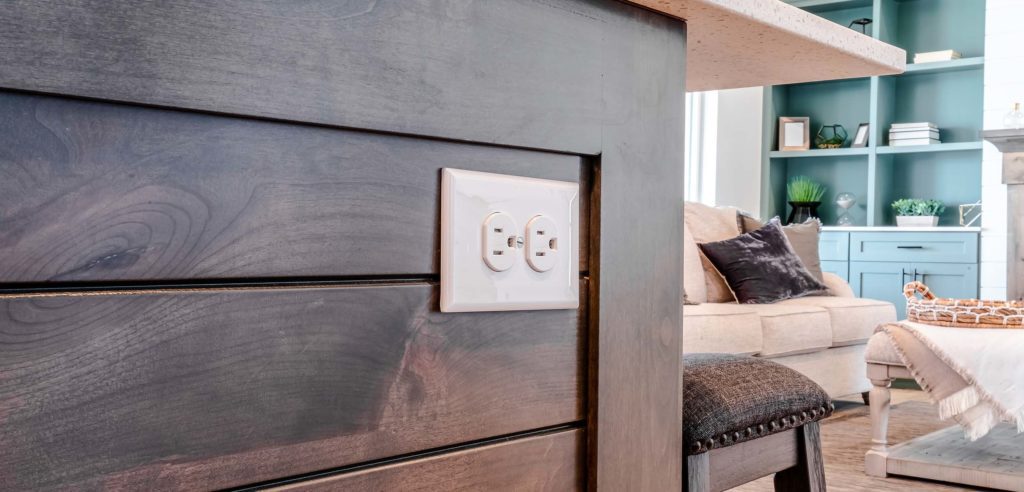For most people, the intricate maze of wires behind their outlets is a mystery. We just expect to plug in our devices and magically have them work. So when your phone doesn’t charge, your alarm doesn’t go off, or you can’t get your morning coffee fix, it’s important to know the reasons why. And important to have the problem fixed.
As technology demand grows, it’s essential your home’s electrical system is up to the task. Electrical problems in the home, even as seemingly small as a broken outlet, can be a safety concern that shouldn’t be ignored.
4-Star Electric’s team of experienced electricians pride themselves on industry-leading technical knowledge and staying at the forefront of home electrical upgrades. Contact our team for your residential quote today.

Outlets, Circuit Breakers, and Fuses, Oh My!
Your home’s electrical system is a unique road map that can be difficult to read when something goes wrong. Here are the most common reasons why your electrical outlets may have stopped working, and what you can do about it.
Tripped Circuit Breakers
Circuit breakers control the electricity that flows through your home. When the current is too high it causes the breaker to switch off, or to trip, ensuring that the circuit does not overheat and cause damage. Each room or set of rooms in your home is on its own electrical circuit.
If a certain outlet in your home has stopped working, head down to the breaker box (or electrical panel), usually located in your mechanical room. If the breaker has tripped, the switch associated with that outlet will be in the middle position, between ON and OFF. Flip it off and then on again to reset your breaker.
Short circuits can occur from an overloaded circuit with too many devices demanding power or for other reasons. If you reset a breaker and shorts continue to occur, it’s best to get an electrician in right away to assess the issue.
Blown Fuses
Much like a circuit breaker, fuse boxes are designed to protect your home from electrical damage by cutting off the flow of electricity when an overload occurs. An overload happens when too many appliances are being plugged in at once or there is a power surge. The main difference between a tripped circuit breaker and a blown fuse is that when a fuse has blown, it has to be replaced.
If your outlet has stopped working, you will find melted metal residue on the glass bulb surrounding the corresponding fuse.
You can replace blown fuses yourself carefully, by following these steps, but many homeowners would rather leave this delicate work to the professionals. Call one of 4-Star Electric’s residential electricians for an estimate today!
Old Outlets
Technology is evolving daily. In the 1960s, Alberta’s electrical code changed, stating all homes must be equipped with 3-prong outlets. But even homes with outlets installed after 1962 can become outdated due to increased power demands. Old outlets can cause multiple electrical problems in your home including inconsistent power and ungrounded electricity, which poses a major safety concern.
Think it’s time for an upgrade? Here are a couple things to watch out for:
- Hot or sparking outlets
- Loose or broken outlet covers
- Flickering lights
- Ungrounded 2-prong outlets
If the outlets in your home are showing these signs of danger, they need to be replaced immediately. Our team can assess your home’s electrical and recommend the best steps for a residential electrical upgrade.
Defective Outlets
You’ve heard of lemons when it comes to cars. Well, sometimes your outlets can be the same. No matter what you try to do to fix them, some electrical components are simply defective.
Replacement receptacles or “plug-ins” can be found at your favourite home improvement store. You can replace defective outlets in your home yourself by following these steps:
1. Turn the power off to the circuit you are working on.
2. Unscrew and remove the outlet cover plate.
3. Make sure there is no power to the outlet by using a voltage tester.
4. Unscrew the receptacle from the electrical box with the wires attached.
5. Remove the wires from the old plug-in and attach them to the new receptacle.
6. Attach the bare or green wire to the receptacle ground wire and to the metal electrical box.
7. Screw the new receptacle into the electrical box and replace the cover plate.
This process requires making sure that you’ve shut off power to the outlet you’re replacing. If upgrading defective outlets is outside your expertise just call 4-Star Electric. A residential technician can visit your home and make sure all your outlets are working properly.

Extend the Life of Your Home’s Electrical System
4-Star Electric’s Home Protection Plan is designed to give you peace of mind and reliable electrical service year-round. This means all the electrical outlets in your home are surveyed and upgraded so there are no surprises.
Benefits of the Home Protection Plan include:
- Priority Service
- Free Electrical Safety Inspections
- Exclusive Special Offers for Members
- A 6-Year Product Guarantee
- A Fully Transferable Membership
Call 4-Star Electric today or speak to your technician during your next service call. You can enroll in the Home Protection Plan before or after service.
So there you have it, reasons why your electrical outlets may have stopped working, and what you can do about it to make sure you never miss your morning alarm due to a faulty outlet again!

